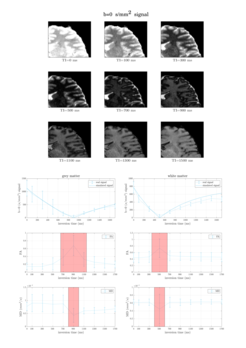Exploring diffusion properties in cortical grey matter using inversion recovery diffusion weighted imaging

The aim of this project is to explore the structurally complex human cortical grey matter (GM) by the different relaxivity (T1) and diffusivity properties of its microstructural compartments. We use inversion recovery diffusion weighted imaging (IR-DWI) acquired for a range of inversion times (TI) in vivo to investigate this compartmentalisation.
Preliminary findings of diffusion tensor-derived fractional anisotropy (FA) and mean diffusivity (MD) parameters show distinct patterns of TI dependence of these parameters in the grey and white matter. While the TI independent FA and MD do not provide any evidence of multiple compartments in white matter, their observed TI dependence reveals multicompartment structure in GM.
We hypothesise that this finding could be explained by compartmentalization at three different spatial scales currently achievable using in vivo DWI. Cortex is organised into intra- and extra-axonal compartments on a microscopic scale; it is organised into cortical laminae on a mesoscopic scale; and can be characterised into cortical areas on a macroscopic scale. We will use dedicated acquisition and analysis to investigate the underlying spatial scale of the observed TI-dependence of FA and MD parameters in cortical GM.
Related publications:
Movahedian Attar F, Dhital B, Edwards L J, Weiskopf N. 2019. Exploring diffusion properties in neocortical grey matter using inversion recovery diffusion weighted imaging. In Proceedings of the 2019 ISMRM Annual Meeting.












